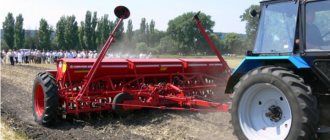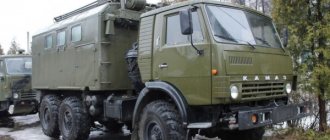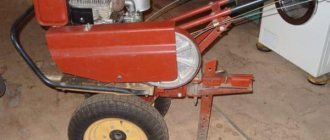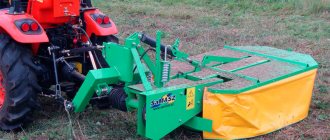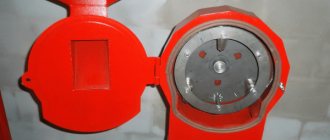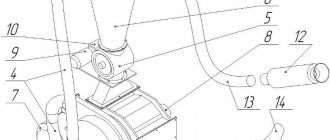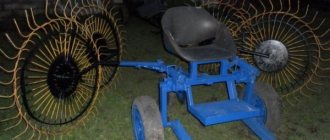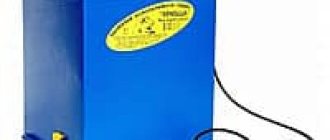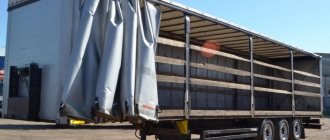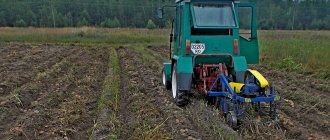Just a few decades ago, owners of country houses and summer cottages spent their leisure time in the fresh air, tending vegetables in their own gardens. With the advent of fashion for recreation areas with green lawns, many are sure to devote part of the garden or local area to arranging such areas where they can cook barbecue, splash in the pool, sunbathe in the sun on a sun lounger, or just have a good time with friends or family.
To make the grass on your lawn look beautiful and thick, you need to sow it correctly. For high-quality sowing, it is better to use a special seeder.
What it is?
A lawn seeder is a manual or mechanical device that not only facilitates and speeds up the process of scattering seeds over the area, but also allows them to be evenly distributed over the entire area.
Hand sowing of grass is not very convenient and can cause uneven entries: in some places the grass may grow too thick, while in others bald spots often form.
Design Features
There are various designs, but the main elements are:
- frame;
- container for seeds;
- opener, with the help of which furrows are formed;
- mechanism for feeding seeds into the seed tube.
Some models also come with a built-in dispenser that allows you to adjust the amount of seed dispensed.
Why do you need lawn seeders: their features and functional properties
Having your own home, a quiet and cozy place where you can at least temporarily escape the annoying bustle of modern life is the cherished dream of more and more people. Making such a dream a reality, many people think about arranging a well-groomed green lawn on their personal plot. Yes, and summer residents too - if possible, of course, they willingly arrange such a place for recreation and children's games on their suburban “acres”.
The best lawn is a dense, without the slightest bald spots, evenly green, well-groomed and neatly trimmed grass “carpet”. And without foreign inclusions, in the form of grass of a different variety or weeds, of course. Special seeders successfully cope with the task of ensuring maximum density and uniformity of the lawn. Because the seeder promotes the distribution of grass seeds in the ground as evenly and frequently as possible.
Despite all the diligence and perseverance, manual sowing of seeds cannot achieve the ideal quality of lawn coverage. Because seeds scattered by hand, in any case, do not fall very evenly into the soil. Even repeated, perpendicular to the first, passes through the area of the future lawn are not able to significantly change the situation. And after the grass has germinated and grown, even if there are no serious bald spots, the density of the grass is somewhere a little higher, somewhere a little lower. This inevitably disrupts uniformity and symmetry, spoiling the appearance and overall impression. Also, a weed that makes its way here and there among the lawn grass can completely destroy the feeling of beauty and well-groomed lawn.
A lawn seeder is a surefire way to achieve the dream of a “House with a Lawn.”
To avoid this, it makes sense to use a lawn grass seeder. So that instead of the expected even grass carpet, you don’t get separately sprouting and asymmetrical tufts of grass: in some places it’s too thick, and in some places it’s not at all. In addition, lawn grass seeders are convenient to use both for their intended purpose and as a machine for applying fertilizers to the soil; for spreading sand; for the distribution of preparations for protecting cultivated plants from pests. Lawn seeders-spreaders have the ability to be used in winter - to evenly spread sand and technical salt along slippery paths.
Functions
Unlike agricultural crops, lawn grass does not need to be replanted every year. It is enough to sow once and enjoy the beautiful appearance of green, fresh and lush grass for many years. For this reason, many may consider buying a seeder not a practical solution.
In fact, this device can be used not only to create a lawn , but also for sowing other crops, spreading granular fertilizers or lime if necessary to lim the soil.
Please note : the technology for sowing lawn grass involves simultaneous scattering of seeds with special fertilizers, which are necessary for the normal development of young seedlings.
If there is an overdose of fertilizer, due to its uneven distribution over the soil surface, areas with burnt grass often form on the lawn.
Another function that a seeder can perform is to better treat plants with drugs against pests and diseases.
Varieties
There are three types of sowing devices:
- Manual.
- Mechanical.
- Professional.
The latest models are used only to create large football fields and golf courses.
The first two types of seeders are used in households. Depending on the model, such structures have different loading hopper volumes and different working widths . The devices can sow seeds in rows or scatter them in a circle using a special rotating mechanism.
Manual
Such devices are a small unit, which in most cases is made of plastic. It is made in the form of a container for loading seeds, at the bottom of which there is a built-in distributor. The container is equipped with a handle, the rotation of which powers the device. Some manual models are equipped not with a rotating handle, but with a button, when pressed, the seeds begin to be ejected from the distributor.
This unit is designed for use on small plots of land . It allows you to easily and quickly disperse seeds, lime, fertilizers, sand or animal and bird feed.
The advantage of manual models is their compact size, ease of use, and budget price.
Another important advantage of a manual seeder is the ability to sow uneven areas where it is impossible to roll units on wheels.
The disadvantage is that the seed distribution is not very high quality and is not always uniform. In addition, in some manual models the shaft may periodically become clogged if so many seeds fall into it at the same time.
Mechanical
With the help of mechanical devices you can easily and quickly sow large areas, but before using them you will need to give the area a perfectly flat surface.
A mechanical seeder is a container with holes at the bottom for seeds . There are wheels under the container, and at the top there is a handle, holding which you can roll the seeder around the site.
More complex mechanical models are equipped with a furrow opener.
One of the advantages of such models compared to manual ones is the larger volume of the seed compartment. Depending on the model, it can range from 10 to 40 liters. A mechanical seeder is capable of scattering seeds over a width of 45 to 300 cm.
The only drawback of such units is their higher cost compared to manual devices.
Models from different manufacturers
There is a fairly wide range of seeder models on sale from different manufacturers. The most popular among them include WE-B from Wolf-Garden, Comfort 800 from Garden, CS 2500 from Texas, Brigadier 86020, PALISAD.
WE-B
The unit is from the German company Wolf-Garden, which has a portable container equipped with a dispenser and a spreading disc mechanism.
The device is also equipped with a battery and batteries. For ease of control, there are keys on its handle. The seeder is capable of scattering seeds at a distance of 0.5-2.5 m.
Thanks to the sufficiently spacious container, one load of seeds is enough to sow lawn grass on an area of about 750 m².
The cost of such a model is about 4,000 rubles.
Comfort 800 from Gardena
The dotted type unit from the German brand is made in the form of a trolley , equipped with a hopper for loading seeds, as well as a handle and two wheels.
The seeder evenly disperses fertilizers and seeds thanks to a special scraper built into the cylinder hopper.
Depending on the model, the volume of the bunker can range from 3 to 20 liters, which allows you to sow areas ranging from 90 to 800 m².
To start the seed feeding process, just turn the lever located on the handle. The device is also equipped with a metering unit that ensures precise seeding frequency.
The price of the model is 2500 rubles.
CS 2500 from Texas
The seeder from Texas (Denmark) is made in the form of a two-wheeled cart with a handle, which is equipped with a hopper for loading seeds. The hopper has a spreading centrifugal mechanism with a dispenser , and there is a control lever on the handle.
The device is activated when it moves forward. The hopper holds about 22 kg of lawn seeds. This amount is enough to sow a plot of 750 m². Seeds are scattered over a width of up to 2 m.
The price of the model is 14,900 rubles.
Brigadier 86020
A manual compact seeder whose weight does not exceed 5 kg. The device is intended for sowing lawn grass and applying granular fertilizers in small areas. It can also be used to spread reagents on roads in the winter.
The seeder has a built-in distributor that allows you to distribute seeds evenly. To control the volume of spilled seeds, it is possible to adjust the size of the hole in the hopper.
The price of this model is 1000 rubles.
PALISAD
The mechanical device of the German manufacturer is made in the form of a trolley on wheels with a hopper . The model consists of steel and plastic. The hopper volume is 12 liters.
The price of the seeder is 2500 rubles.
Range of modern seeders
If making a planting unit yourself causes difficulties, it is recommended to immediately purchase ready-made structures. The assortment on the market is quite large. The American model of precision seeding “1001 - B” is equipped with 6 replaceable discs. With such a seeder you can plant 28 types of vegetable crops. Using the adjusting screw, you can change the planting depth.
Newtechagro seeders are single-row types. Designed for sowing beets, carrots, onions, and cabbage . But such designs are expensive.
But there are also cheaper analogues - precision seeders "SOR - 1/1". They are also single-row, can be equipped with a bush or brush sowing unit, the row marker is 0.5 m. This is quite enough for an average garden.
Using a manual seeder can significantly reduce labor costs, increases the speed of the planting process, simplifies the technology, significantly improves the quality of crops, and hence excellent harvests in the future.
How to choose?
When choosing a seeder for lawn grass, you need to consider the following parameters:
- Plot area - for a small lawn, a manual seeder is suitable, but for large areas it is better to purchase a mechanical device in the form of a cart on wheels.
- The presence of unevenness on the soil surface - for working on hilly, uneven terrain, it is better to use a manual seeder. If the surface is flat, then a unit on wheels is suitable.
- Manufacturing materials - when choosing a seeder, you should give preference to models made of metal, as they are more durable and durable. However, their cost will be significantly higher compared to their plastic counterparts.
- The presence of a dispenser that will allow you to sow seeds in an even layer and ensure their economical consumption.
How to avoid mistakes when choosing a device
There are some common myths and prejudices among consumers that should be avoided:
Myth No. 1
High cost guarantees quality and performance. Yes, as a rule, truly high-quality products are more expensive. But you can’t focus only on brand and price. There is no point in purchasing a high-performance automated device for sowing a couple of small lawns of one or two hundred square meters. Perhaps he simply will have nowhere to turn around.
Myth No. 2
The terrain doesn't matter. This statement is only true for manual seeders. To work on an unprepared surface, you should choose devices with pneumatic wheels that have good maneuverability.
Do you use a seeder when seeding your lawn?
Of course! No, but I will!
Myth No. 3
Larger area means larger bunker. When it is necessary to sow a large area, it is not the capacity that matters, but the width of the bunker. Whatever its volume, with a small width you will have to make more passes and spend more time.
The variety of lawn seeders available on the market allows you to reduce wasted time on manual labor and solve almost any problem. With their help, you can arrange a small lawn at your dacha or seed an entire football field. They will help fertilize the lawn and protect it from pests, and in winter, protect people from falls and injuries by evenly distributing deicer or sand along walkways. The main thing is to choose equipment that matches the volume of work and the characteristics of the site.
Can I do it myself?
If you have certain skills in making various mechanisms and devices, you can make a seeder with your own hands. Although homemade models are usually inferior in appearance to store-bought ones , carefully thought out details of the future design and its correct manufacturing will result in a fully functional seeder.
What tools are needed?
To make a homemade product you will need:
- drive wheel;
- two small wheels;
- opener, boards;
- 2 sprockets from under an old bicycle;
- canister;
- metal strip;
- small diameter metal pipes;
- welding machine;
- Bulgarian;
- spanners.
Process of creation
Manufacturing work is carried out in this order:
- To power the seeder, you will need a drive wheel. It can be removed from a drive that is no longer needed.
- Using a welding machine, the wheel must be welded to the hub, which is located on one of the opener disks.
- Next, you will need to tension the chain from the bicycle onto the sprockets.
- Then you need to bend thin pipes and make a base from them, and then attach to it a canister with holes made at the bottom for seeds, and a handle made of a metal strip.
- 2 wheels are attached to the bottom of the seeder.
Pros and cons of the solution
The main advantage of the decision to make a seeder yourself, from improvised means, is the opportunity to significantly save money on the purchase of a ready-made unit.
The disadvantage of this solution may be any error made during the manufacturing process of the device and its ineffective operation. Another disadvantage is the insufficiently aesthetic appearance of the homemade structure.
Rules and technology of application
Sowing work must be carried out in calm weather , and the soil must be dry.
Before sowing, the surface of the lawn is leveled with a rake and compacted with a roller.
Then the seed is poured into the hopper and the unit is put into operation. To do this, you will need to push it forward and at the same time begin to rotate the handle.
Tip : to ensure uniform sowing of the entire area, you can use the cross method, in which the seeder is first rolled along the area and then across.
Possible mistakes
The following problems may occur during use::
- Poor seeding in difficult terrain with depressions and mounds when choosing a wheeled spreader. The smaller the wheels, the more difficult it will be to roll on uneven ground. For such areas, it is better to use a hand seeder, or carefully level the surface first.
- Choosing a planter that is too small with a small hopper capacity for a large lawn. In this case, you will have to spend much more effort and time to sow than when using a device with a large hopper, which allows you to scatter the seeds over a width of 1.5-2 m.
- Incorrect adjustment of the intensity of seed dispersal can cause too thick seedlings and high seed consumption, or the formation of bald spots and insufficiently dense seedlings.
Advantages and disadvantages
When sowing a lawn manually, without using a spreader, it is important to adhere to the correct planting technology and ensure that the seeds lie on the soil surface in as even a layer as possible.
Using the seeder allows you to:
- achieve uniform seedlings and get a beautiful, high-quality lawn;
- significantly simplify the work and reduce the time to complete it;
- simultaneously with sowing the seeds, treat the area with fertilizers for lawn grass;
- use the seeder in the future for lawn care: treat the grass against diseases and pests, scatter fertilizers.
The disadvantages of using a spreader include the need to spend money on its purchase.
Reviews from owners of lawn grass seeders
On the Internet you can find many reviews about lawn seeders, which often begin with the fact that their future owners were at first quite skeptical about the need to purchase such equipment. However, after trying it in action, they changed their minds. Indeed, it is convenient to use, saves time and nerves, and gives wonderful results. A smooth, dense lawn that brings considerable moral and aesthetic satisfaction to its owner. The owners note that the seeder becomes an indispensable assistant for this reason. Lawn grass seeds are very thin and small, so sowing them evenly by hand is quite a labor-intensive and difficult task. After the grass has sprouted, you need to repeat the sowing procedure several more times, achieving an impeccable result. With a lawn seeder, the same desired result is achieved much faster, more conveniently and easier.
“Refilling” the Gardena seeder with lawn grass seeds.
We are also pleased with the extreme simplicity of the design and use of such seeders. There is simply nothing to break in them, and in order to disable them, you need to set such a goal; it won’t work any other way. A lot of reviews also say about the need to carefully level the area for sowing the lawn; adding sand there and mixing it with soil; about the use of quality seeds. But this is, as they say, “a completely different story.”
